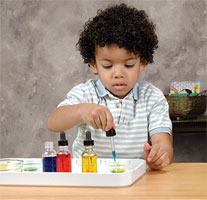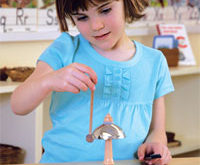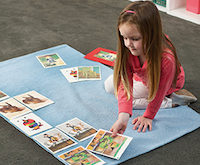A fiv e-year-old boy had been working with the Geometric Solids in my classroom. On the weekend, his family took a drive out to the countryside. His mother reported that her son, seeing a grain silo for the first time, pointed to it with great excitement and said, “Look, Mom. There’s a cylinder with a cone on top!”
e-year-old boy had been working with the Geometric Solids in my classroom. On the weekend, his family took a drive out to the countryside. His mother reported that her son, seeing a grain silo for the first time, pointed to it with great excitement and said, “Look, Mom. There’s a cylinder with a cone on top!”
Why is the Sensorial curriculum so important in the primary classroom? Maria Montessori emphasized that there is a sensitive period for children, ages three to six, “when there is a natural inclination to perfect one’s senses and movements.” (Discovery of the Child) Understanding that young children learn by moving and exploring through their senses, Montessori developed the elegant Sensorial apparatus, which introduces abstract concepts (for example, long, broad, tall) with concrete objects.
Isolating One Quality
The Sensorial materials help children explore and refine the five classic senses of sight, hearing, taste, touch, and smell, as well as the complex senses of thermic (temperature), baric (weight), and stereognostic (identifying objects by size and shape, based on touch alone). Each material isolates one quality, such as color, shape, roughness, or length, and then varies just that one quality. This isolation of what’s different in just one aspect allows children to perceive the “Piagetian cognitive skills such as one-to-one correspondence, classification and seriation.” (Chattin-McNichols, The Montessori Controversy)
Sensorial Games and Variations
We can challenge a child who has mastered the basic presentations of the Sensorial apparatus by showing games such as matching from memory, grading from memory, and then adding complexity by grading from any point in the series. For example, place the Red Rods on one rug and then carry a medium length Red Rod to a second rug on the other side of the classroom. Ask the child to fetch the Red Rod that is “the next longer than this one.” Vary this activity by asking for the rod that is the next shorter. These same games can be played with many of the Sensorial materials such as the Bells, Pink Tower, Brown Stair, and Sound Boxes.
The more complex exercises and variations are intended to spark interest in the child to continue to work with and explore the materials. Montessori stressed that children will spontaneously experiment with and create many combinations and patterns with the Sensorial materials. Rather than demonstrating these combinations, allow children to discover them!
We can ask open-ended questions to encourage children to use the Sensorial materials in a different, creative way: “Are there any other objects in the room that look like the sphere?” In this way children might discover that the globe is a sphere and the light cover on the ceiling is a sphere. Children may discover on their own the relationships and similarities between the Pink Tower and the Brown Stair, or between the Knobbed and Knobless Cylinders.
Sensitize the Fingertips
Many teachers don’t show children how to sensitize their fingertips, which is an activity that will optimize experiences with the tactile materials (the Rough and Smooth Boards, the Sandpaper Letters). Show children how to soak their fingertips in warm water and then gently stimulate the fingertips while drying them with a towel. Not only does it prepare children’s fingertips to be more sensitive, it also teaches respect for the materials and helps to keep them beautiful and clean.
Keep It Fresh: Sensorial Extensions
- Read the book The Listening Walk and then take the children on a listening walk. How many different sounds can they hear and identify?
- How about a smelling walk? Especially when flowers are in bloom, after a rainfall, or when the grass has been freshly mown.
- Cooking with children is a marvelous time to appreciate smells: vanilla, cinnamon, apples, lemons, the smell of yeast when making bread. Touch can be refined by noticing the feel of flour, the textures of fruits and vegetables.
- Use fresh herbs from the garden to put seasonal scents in the Smelling Bottles.
- The Progressive Exercise: Use corks, buttons, shells, or beads of increasing size. Children grade items progressively from largest to smallest.
- As an extension of the Tasting Bottles, show older children a diagram of the tongue highlighting which area is most sensitive to which taste (bitter, sweet, sour, salty). Children can place the same taste on different parts of their tongue to see if they notice the sensitivity.
Blindfolds Increase the Challenge!
Montessori noted that the eye can interfere with what the hand knows. Using a blindfold with the following exercises will isolate the tactile sense.
- The Mystery Bag: Name each item as you place it in a mystery bag. The more surprising and varied the better! For example: a key, marble, pinecone, walnut, peach pit, candle, thimble, ball of wool, stone. When blindfolded, the child feels each item and identifies it before removing it from the bag.
- Place rough and smooth rocks or shells in a mystery bag for the children to sort into the two categories of rough and smooth. Then grade them: “Can you find one that is smoother?”
- Sorting Grains: Place a small amount of two different grains, beans, or seeds into one bowl. Invite the child to sort the grains from the mixture. Later add another grain, varying the combinations using wheat, rice, barley, lentils, peas, beans, mustard seeds, coffee beans. Using a blindfold helps the child concentrate on what he’s feeling.
Have fun being creative as you set up new Sensorial exercises in your classroom. Be sure to isolate one attribute at a time and to make the activity aesthetically beautiful. Give the initial lesson with a minimum of words, keeping the focus on the material rather than on you. Then stand back and observe without interrupting the child. Give yourself the gift of watching children as they use their senses to explore and discover.
 Montessori blog Montessori blog
Montessori blog Montessori blog 


Hi i am kavin, its my first occasion to commenting anywhere,
when i read this article i thought i could also make comment due to this brilliant paragraph.
Pretty section of content. I just stumbled
upon your blog and in accession capital to assert that I acquire actually enjoyed account your blog posts.
Any way I’ll be subscribing to your feeds and even I achievement you access consistently quickly.
Fantastic site you have here but I was wanting
to know if you knew of any user discussion forums that cover the
same topics discussed in this article? I’d really love to be a part
of community where I can get suggestions from other experienced people that share the same interest.
If you have any recommendations, please let me know.
Appreciate it!
I’m very happy to discover this web site. I need to to thank
you for your time due to this wonderful
read!! I definitely savored every part of it and i also have
you book marked to check out new information in your site.
Hi, i think that i saw you visited my site thus i got here to return the favor?.I’m trying to to
find things to improve my web site!I suppose its adequate to make use of some of your ideas!!
Hello, I do believe your web site could be having browser compatibility problems.
Whenever I take a look at your website in Safari, it looks fine however, when opening in Internet Explorer, it’s got some overlapping issues.
I just wanted to give you a quick heads up! Aside from that, fantastic site!
I don’t even know how I ended up here, but I thought this post was good.
I don’t know who you are but definitely you are going to a famous blogger
if you aren’t already 😉 Cheers!
Everything is very open with a clear clarification of
the challenges. It was definitely informative. Your website is
very useful. Many thanks for sharing!
Does your website have a contact page? I’m having trouble locating it but, I’d like to shoot you an email.
I’ve got some suggestions for your blog you might be interested in hearing.
Either way, great blog and I look forward to seeing it grow over time.